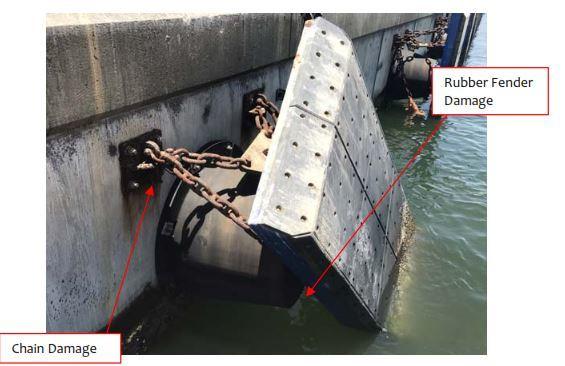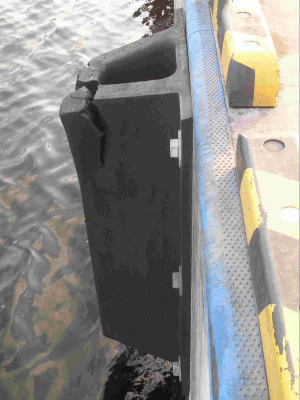Cause of damage to rubber fender

1.Overload of the ship
This type of damage often occurs in the rubber fender, especially some old rubber fender, which often cracks at the weak part of the structure. The crack is generally in the length direction of the rubber fender. D-type and V-type fenders are common to see. The main cause of cracking of the rubber fender is that the kinetic energy of the ship striking the fender is too large to exceed the load that the rubber fender can withstand. The reason for the excess kinetic energy of the ship is that the berthing speed and the berthing angle are too large. Especially when the berthing angle is large, the bow cracks the pier and the rubber fender before the middle of the hull, causing powerful impact kinetic energy to concentrate on one or several fenders, leading damage to the rubber fender. Besides the above reasons, ships that are larger than the designed ship type and waving wind also lead the berthing overload.
2.Poor anchoring and connection
It happens in all types of rubber fenders. Rubber fender has abnormal phenomena like loose, out of position, off into the sea and so on. The main reason for this phenomenon is that the bolts or chains used to anchor the fender are not in good technical condition, or the maintenance has not kept up with it. Metal materials such as anchor bolts and iron chains used to fix the fender corrode rapidly in the marine environment and are not easy to be replaced, resulting from the poorly fixed rubber fender and thus seriously affecting the normal use of the fender. Though replacement conditions of some anchor bolts are considered in the design, they are working well in practical use. Such as v-type rubber fender anchor bolt shall be in the form of a pre-embedded bolt. The original design intention is to facilitate the maintenance and replacement of anchor bolts, but in actual use due to iron corrosion, bolt deformation and other reasons and cannot be replaced, which affects the quality of rubber fender fixed, leading fender to fall off and damage.
3.Friction damage
This usually occurs in fixed V and D-type fenders. The fender damage phenomena are mainly like angle drop, cracking and surface abrasion. The main reason for this damage is the huge friction between the rubber fender and the ship. When the ship approaching the shore at a large tangential speed, the contact part between the rubber fender and the ship is forced to move forward with the ship due to excessive friction force, leading the damage of the fender. In addition, during the mooring operation, the ship sometimes moves back and forth, as well as caused by waves and currents left and right or up and down sway, etc. In this case, when the friction coefficient between the ship and the rubber fender is larger than 0.4 like mooring rope is stretched too tight, it can cause the damage to fenders.


